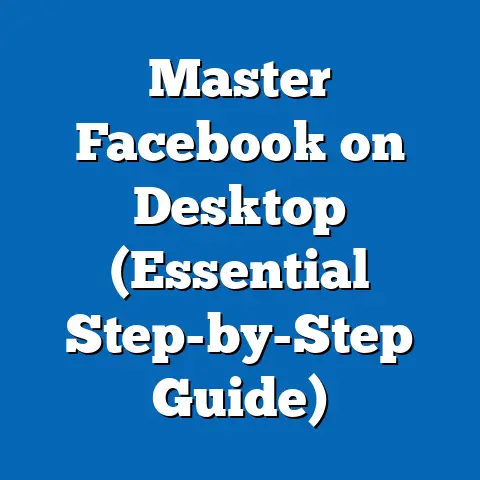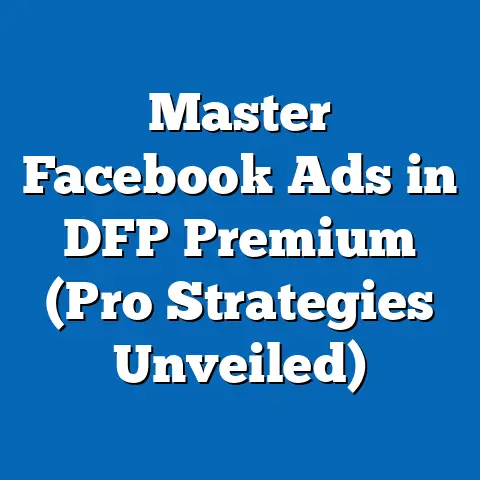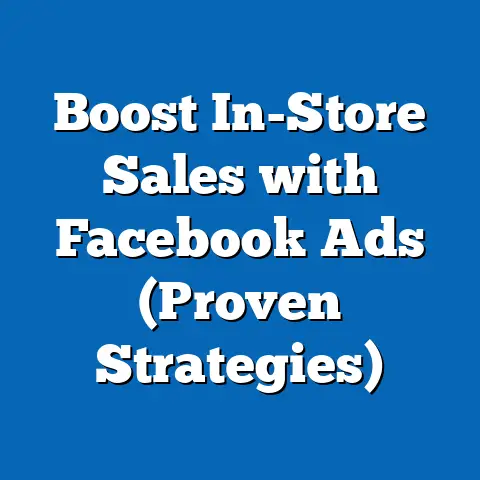Optimize Facebook Ad Square Size (Essential Guide)
In an era where digital platforms evolve at breakneck speed, future-proofing marketing strategies is no longer a luxury but a necessity. As social media advertising continues to dominate the digital landscape, platforms like Facebook (now under Meta’s umbrella) remain central to reaching diverse audiences. One critical yet often overlooked aspect of crafting effective Facebook ads is the optimization of ad dimensions, particularly the square ad format, which has become increasingly versatile across various placements.
Future-proofing in this context means anticipating platform updates, user behavior shifts, and technological advancements to ensure that ad content remains visually impactful and functionally relevant. The square ad format, typically a 1:1 aspect ratio, is a cornerstone of adaptable design, offering compatibility with multiple placements such as News Feed, Stories, and Marketplace on both desktop and mobile devices. This article explores the key defining characteristics of optimized square ad sizes, traces the historical evolution of Facebook advertising formats, and examines the broader societal and business implications of mastering this format in an ever-changing digital ecosystem.
Defining Characteristics of Optimized Facebook Ad Square Size
The square ad format on Facebook is defined by its 1:1 aspect ratio, meaning the width and height of the image or video are equal. The recommended resolution for square ads is at least 1080×1080 pixels, though higher resolutions are encouraged to maintain clarity across high-definition screens. This format is prized for its visual balance, allowing advertisers to maximize screen real estate on mobile devices, where the majority of Facebook users—over 98% as of 2023, according to Statista—access the platform.
Unlike other aspect ratios such as vertical (9:16) or horizontal (16:9), the square format offers a neutral canvas that minimizes cropping issues when ads are displayed across different placements. Its symmetry ensures that key visual elements remain centered and uncompromised, whether viewed in a user’s News Feed or within an Instagram Story cross-posted from Facebook. Additionally, square ads often achieve higher engagement rates due to their ability to stand out in a scroll-heavy environment, as noted in a 2022 study by Hootsuite, which found that 1:1 ads garnered 15% more clicks than other formats in mobile feeds.
However, optimization goes beyond mere dimensions. It involves strategic design choices, such as ensuring text occupies no more than 20% of the image to comply with Facebook’s ad guidelines, and leveraging high-contrast visuals to capture attention in a split second. These characteristics make square ads not just a technical specification but a dynamic tool for storytelling and brand communication in a crowded digital space.
Historical Context: The Evolution of Facebook Ad Formats
To understand the significance of square ad optimization, it’s essential to trace the evolution of advertising on Facebook since its inception. Launched in 2004 as a social networking site for college students, Facebook introduced its first advertising product, Flyers, in 2006, targeting niche campus communities with rudimentary banner-style ads. These early formats were limited by both technology and user expectations, often appearing clunky and intrusive on desktop interfaces.
The shift to mobile-first design in the early 2010s marked a turning point. With the rise of smartphones and the launch of the Facebook mobile app, the platform recognized the need for ads that could adapt to smaller screens and varied user behaviors. By 2012, the introduction of News Feed ads brought a more native advertising experience, blending promotional content with organic posts. This era also saw the emergence of multiple aspect ratios, as advertisers grappled with balancing desktop and mobile visibility.
The square format gained prominence around 2015, coinciding with the explosive growth of Instagram (acquired by Facebook in 2012) and the increasing importance of mobile-first content. Instagram’s grid layout, which favored square images, influenced cross-platform strategies, prompting Facebook to advocate for 1:1 ads as a versatile solution. Historical data from Social Media Examiner shows that by 2017, square ads were outperforming other formats in terms of cost-per-click efficiency, largely due to their adaptability and visual appeal on mobile devices.
Significant events, such as the 2018 Cambridge Analytica scandal and subsequent privacy regulations, also reshaped ad strategies by emphasizing transparency and user trust. Advertisers began focusing on visually authentic content that could convey messages quickly without relying heavily on text, further cementing the square format’s role as a concise, impactful medium. Today, as Meta pushes toward immersive experiences like augmented reality and the metaverse, the square ad remains a foundational format, adaptable to emerging technologies while maintaining compatibility with current placements.
Societal Implications: The Broader Impact of Ad Optimization
The optimization of Facebook ad square sizes extends beyond marketing metrics; it reflects and influences broader societal trends in communication, technology, and consumer behavior. At its core, the shift toward mobile-friendly formats like 1:1 mirrors the global transition to smartphone dependency. According to a 2023 report by Pew Research Center, over 85% of adults in developed nations own a smartphone, with usage rates even higher among younger demographics like Gen Z and Millennials. This societal reliance on mobile devices has redefined how information is consumed, prioritizing quick, visually engaging content over lengthy text or desktop-centric designs.
Square ads also play a role in shaping cultural narratives by enabling brands to connect with diverse audiences through inclusive, accessible visuals. Their balanced format allows for creative storytelling that resonates across generational and cultural lines, whether through vibrant imagery or short, emotive videos. For instance, campaigns addressing social issues—such as sustainability or mental health—often leverage square ads to maximize reach and emotional impact, as seen in initiatives by global brands like Nike and Coca-Cola during the 2020s.
Economically, the focus on optimized ad formats has democratized advertising to an extent, allowing small businesses and individual creators to compete with larger corporations. The square format’s simplicity and compatibility reduce the need for expensive, specialized design tools, enabling entrepreneurs to craft professional-looking ads with minimal resources. However, this also raises concerns about ad saturation and digital fatigue, as users are bombarded with increasingly polished content, potentially leading to reduced trust or engagement over time.
Moreover, the societal push for data privacy and ethical advertising, spurred by regulations like the GDPR in Europe and CCPA in California, has indirect implications for ad optimization. Advertisers must balance visual appeal with transparency, ensuring that square ads not only attract attention but also build trust through clear messaging and authentic branding. As society grapples with the ethical dimensions of digital marketing, the role of optimized formats in fostering positive user experiences becomes even more critical.
Technical Nuances: Best Practices for Square Ad Optimization
Optimizing square ads on Facebook requires a blend of technical precision and creative strategy. The platform’s official guidelines recommend a minimum resolution of 1080×1080 pixels, with a maximum file size of 30MB for images and 4GB for videos. For video ads, a length of 1 to 240 seconds is supported, though shorter durations (15-30 seconds) often perform better in capturing attention, as per a 2021 study by Wistia.
Design considerations are equally important. Advertisers should prioritize high-quality visuals with strong focal points at the center of the frame to account for potential cropping in certain placements. Text should be minimal—ideally under 20% of the image area—to avoid rejection by Facebook’s automated review system, which flags excessive text as low-quality content. Tools like Canva or Adobe Spark can help non-designers create compliant, visually appealing ads by offering templates tailored to the 1:1 ratio.
Color psychology and branding consistency also play a role in optimization. Bright, contrasting colors tend to stand out in a crowded feed, while consistent use of brand colors and logos reinforces recognition. A 2022 analysis by HubSpot found that ads with cohesive branding elements saw a 23% higher recall rate among viewers compared to generic designs.
Testing and iteration are crucial for long-term success. Facebook’s Ads Manager provides robust analytics on metrics like click-through rate (CTR), engagement, and cost-per-impression (CPM), allowing advertisers to A/B test different square ad designs. For example, testing variations in call-to-action (CTA) placement or imagery can reveal what resonates most with a target audience, ensuring continuous improvement in a dynamic digital environment.
Comparative Analysis: Square Ads vs. Other Formats
While the square format offers unique advantages, it’s worth comparing it to other popular aspect ratios to understand its role within a broader ad strategy. Vertical ads (9:16), for instance, dominate in placements like Stories and Reels, where full-screen immersion is key. According to Meta’s 2023 advertising report, vertical ads achieve up to 30% higher completion rates in Stories compared to square formats, making them ideal for narrative-driven campaigns.
Horizontal ads (16:9), on the other hand, are better suited for desktop placements or video content designed for platforms like YouTube, where widescreen viewing is the norm. However, they often lose impact on mobile News Feeds due to cropping or reduced visibility. A 2020 study by Socialbakers highlighted that horizontal ads had a 12% lower engagement rate on mobile compared to square ads, underscoring the latter’s mobile-first advantage.
Square ads strike a balance between these extremes, offering versatility across placements without sacrificing too much real estate. Their adaptability makes them a safe choice for advertisers targeting mixed audiences on both mobile and desktop, though they may lack the immersive punch of vertical formats in specific contexts. The key takeaway is that while square ads are not a one-size-fits-all solution, their compatibility and engagement potential make them a cornerstone of diversified ad campaigns.
Economic and Business Impacts: Why Optimization Matters
From a business perspective, optimizing square ad sizes directly impacts return on investment (ROI) in digital marketing. Poorly formatted ads—those with low resolution, excessive text, or improper cropping—risk higher rejection rates by Facebook’s algorithm, leading to wasted budgets and missed opportunities. Conversely, well-optimized square ads can lower cost-per-click (CPC) by improving relevance scores, as noted in a 2022 report by WordStream, which found that high-quality visuals correlated with a 20% reduction in CPC.
For small and medium-sized enterprises (SMEs), mastering square ad optimization can level the playing field against larger competitors. With global ad spend on social media projected to reach $219 billion by 2024 (eMarketer), even marginal improvements in ad performance can translate to significant savings or revenue gains. Moreover, optimized ads contribute to brand credibility, as professional visuals signal reliability and attention to detail—key factors in consumer trust.
In the workplace, the focus on ad optimization has spurred demand for digital marketing skills, particularly in graphic design and data analytics. Companies are increasingly investing in training or hiring specialists who can navigate Meta’s evolving guidelines and tools, reflecting a broader shift toward data-driven marketing cultures. This trend also highlights the need for cross-departmental collaboration, as creative teams, analysts, and strategists must align to produce cohesive, high-performing ads.
Cultural and Social Factors Influencing Ad Design
Cultural and social dynamics play a significant role in how square ads are perceived and optimized. Generational differences, for instance, influence design preferences—Gen Z users often gravitate toward bold, meme-inspired visuals, while Baby Boomers may respond better to clear, straightforward messaging. A 2023 survey by Sprout Social revealed that 68% of Gen Z users valued authenticity in ads, prompting brands to use real user-generated content in square formats to build relatability.
Social movements also shape ad content. The rise of inclusivity and diversity as cultural priorities has led advertisers to showcase varied demographics in their visuals, using the square format’s balanced canvas to highlight faces and stories effectively. Similarly, the growing emphasis on sustainability has encouraged brands to adopt minimalist designs in their ads, aligning with eco-conscious values while adhering to text limitations.
Technological advancements, such as the integration of AI in ad creation, further influence optimization strategies. Tools like Meta’s Advantage+ creative suite allow advertisers to automatically adjust square ads for different placements, reducing manual workload while maintaining quality. As these technologies evolve, they will likely redefine best practices, making adaptability a key skill for marketers.
Diversity Within Audiences: Avoiding One-Size-Fits-All Approaches
While square ads offer broad compatibility, it’s critical to recognize the diversity within target audiences and avoid oversimplified assumptions. Not all users interact with ads in the same way—cultural backgrounds, socioeconomic status, and personal interests shape how content is received. For example, rural users with slower internet connections may struggle with high-resolution video ads, necessitating lighter image-based square formats.
Similarly, accessibility considerations must be factored into design. Including alt text for images and captions for videos ensures that square ads are inclusive to users with visual or hearing impairments. A 2021 report by the World Health Organization estimated that over 1 billion people globally live with some form of disability, underscoring the importance of accessible ad content in reaching the widest possible audience.
Psychographic segmentation—understanding user values, lifestyles, and behaviors—also enhances optimization. Tailoring square ads to reflect niche interests or local trends can boost engagement, as seen in hyper-targeted campaigns by brands like Spotify, which use data-driven personalization to create culturally relevant visuals. This nuanced approach acknowledges that while the square format is versatile, its execution must be customized to resonate with specific audience subsets.
Forward-Looking Insights: The Future of Square Ads in a Changing Landscape
Looking ahead, the role of square ads in Facebook advertising will likely evolve alongside technological and societal shifts, though uncertainties remain. The continued growth of mobile usage suggests that mobile-first formats like 1:1 will retain their relevance, especially as emerging markets gain internet access primarily through smartphones. However, the rise of immersive technologies, such as virtual reality (VR) and augmented reality (AR), may challenge traditional ad formats, requiring square ads to adapt to 3D or interactive environments within the metaverse.
AI and machine learning will also shape the future of ad optimization. Predictive algorithms could automate the design of square ads based on real-time user data, minimizing human error and maximizing performance. Yet, this raises ethical questions about privacy and over-reliance on technology, areas that regulators and consumers will scrutinize in the coming years.
Societally, the balance between ad saturation and user experience will be a key concern. As platforms like Facebook refine their algorithms to prioritize meaningful content over promotional material, advertisers may need to focus even more on authentic storytelling within square formats. The challenge will be to maintain engagement without contributing to digital fatigue, a growing issue as users spend an average of 2.5 hours daily on social media, per a 2023 GlobalWebIndex report.
Finally, economic factors such as inflation and shifting ad budgets could influence optimization strategies. If ad costs rise, businesses will demand greater efficiency from formats like square ads, pushing for innovations in design and targeting. While the exact trajectory is unclear, one certainty emerges: mastering square ad optimization today equips marketers with the agility to navigate tomorrow’s uncertainties.
Conclusion: Building Resilience Through Optimization
Optimizing Facebook ad square sizes is more than a technical exercise; it’s a strategic imperative for future-proofing digital marketing in a rapidly evolving landscape. By understanding the defining characteristics of the 1:1 format, appreciating its historical evolution, and addressing its societal implications, advertisers can craft campaigns that resonate across generations, cultures, and platforms. The balance of technical precision, creative storytelling, and audience awareness ensures that square ads remain a powerful tool for engagement and brand growth.
As we look to the future, the adaptability of square ads positions them as a cornerstone of digital advertising, capable of weathering technological disruptions and societal shifts. Yet, success requires ongoing learning and experimentation, as well as a commitment to ethical, inclusive practices. In a world where change is the only constant, optimizing square ads offers not just a competitive edge but a pathway to meaningful connection in the digital age.






